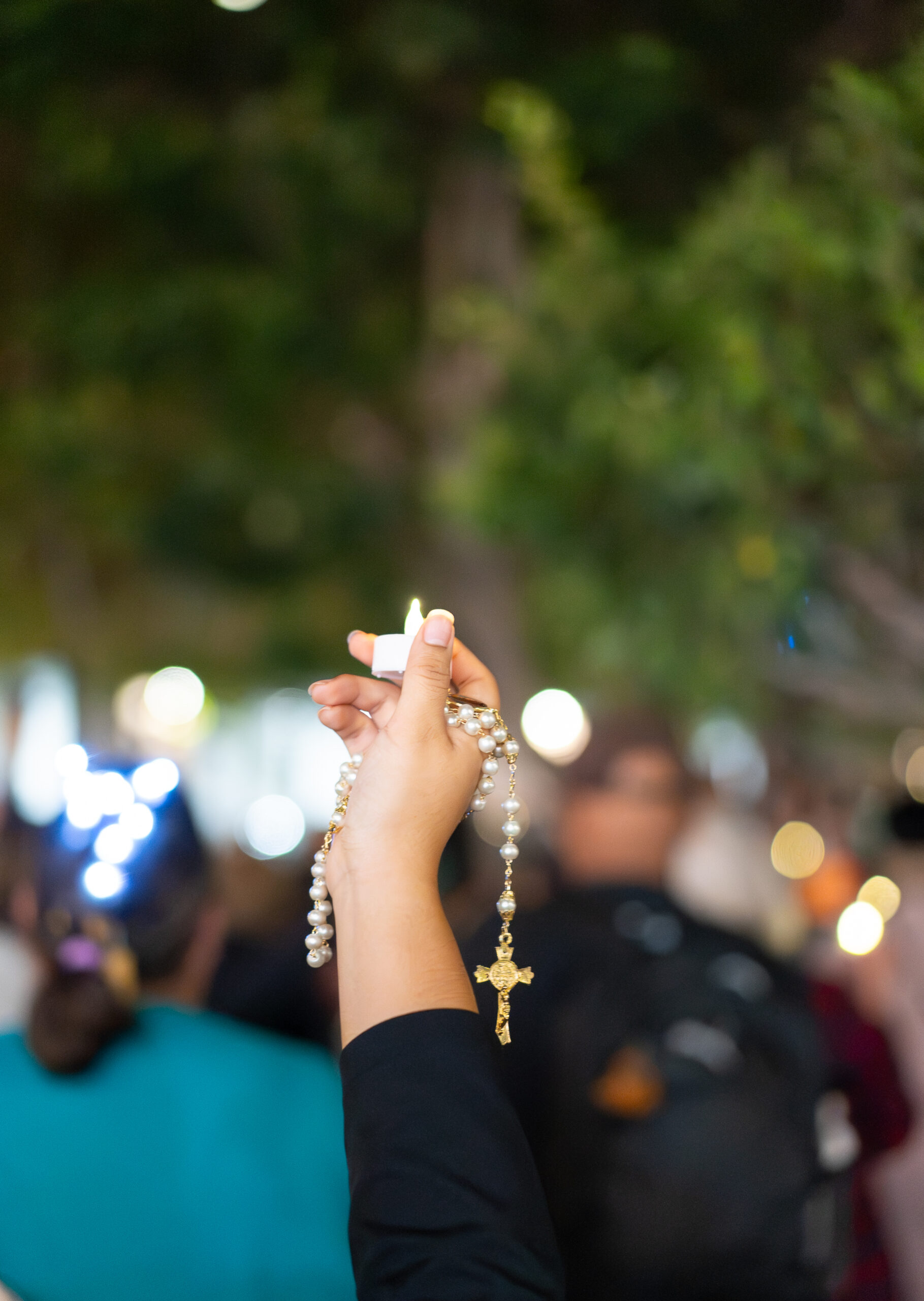Faith at the Federal Building: Praying for Our Detained Neighbors
On Thursday, November 13, just after sunset, hundreds gathered outside the Edward J. Schwartz Federal Building. Clergy in their collars, families with children, young and old holding candles, longtime advocates, and neighbors walking by–all drawn to an urgent purpose. They did not come for a political demonstration. They came to pray.
The prayer vigil, organized with leadership from San Diego Organizing Project (SDOP), focused on the immigrants who have been detained in the courthouse basement–some reportedly without adequate food or care, and in some cases, for an extended time. Participants lifted their voices in prayer, lament, and hope. They sang. They held silence. They looked toward a building where people were suffering out of public view, and said, “You are not forgotten.”
 Prayer is often thought of as personal–something private; something for the quiet moments in our homes or church pews. But throughout Scripture, prayer moves into the streets, the courtyards, the city gates. Prayer shows up in places where suffering is visible.
Prayer is often thought of as personal–something private; something for the quiet moments in our homes or church pews. But throughout Scripture, prayer moves into the streets, the courtyards, the city gates. Prayer shows up in places where suffering is visible.
In Acts 16:25-26, Paul and Silas publicly prayed and sang outside a prison:
About midnight Paul and Silas were praying and singing hymns to God, and the prisoners were listening to them. Suddenly there was an earthquake, so violent that the foundations of the prison were shaken; and immediately all the doors were opened and everyone’s chains were unfastened.
That night, the Episcopal Diocese of San Diego (EDSD) took prayer to the public square, under streetlights, within sight of Federal employees working into the evening. Prayer happened in whispers and in songs, in silence and in spoken word, in the hands held between strangers and in the tears shared by people who understand the pain.
There is something very Christian about praying in the very place where harm is happening. It is not a performance. The Ven. Cindy Campos, Archdeacon, said, “God is here, too. God does not abandon suffering. And neither do we.”
Over 25% of the Episcopal congregations in our diocese were represented. Our clergy and lay members offered more than prayers—they offered presence, solidarity, and a message that the dignity of every person matters to us.
David Jay, member of Good Samaritan Episcopal Church and the congregation’s representative on the SDOP board, said, “It was powerful to gather with friends from across the diocese and members of so many San Diego faith communities. It is our duty to be a voice for those who are being held without due process and to let their children and families know that we see them and care for them as our neighbors.”
 Even though those detained in the courthouse basement may never know that people gathered above them, the act of showing up still carries real human significance. Public witness and prayer change the environment around suffering. When a community stands in prayer outside a place of harm, it names that harm and insists that what is happening behind closed doors is worthy of our moral attention. It tells the city, its leaders, and all who pass by that people’s lives matter, even when those detained cannot hear the prayers being spoken on their behalf.
Even though those detained in the courthouse basement may never know that people gathered above them, the act of showing up still carries real human significance. Public witness and prayer change the environment around suffering. When a community stands in prayer outside a place of harm, it names that harm and insists that what is happening behind closed doors is worthy of our moral attention. It tells the city, its leaders, and all who pass by that people’s lives matter, even when those detained cannot hear the prayers being spoken on their behalf.
In a season when many feel powerless, the act of gathering in prayer brings solidarity and strengthens the resolve of those working toward justice. The vigil may not reach the detainees directly, but it strengthens the community that surrounds them, reminding all of us that suffering should never go unacknowledged or unanswered.
For Episcopalians in the Diocese of San Diego, showing up does not end at the building’s steps. Through EDSD’s participation in the “Faithful Accompaniment in Trust and Hope” program (FAITH), volunteers now show up inside the courtroom, sitting beside immigrants facing hearings, offering the same message of dignity, solidarity, and presence in a context that is incredibly isolating.
In the courtroom, the presence of a volunteer is not legislative or legal advocacy; it is a spiritual and relational presence. In an EDSD News article from September 9, 2025, Archdeacon Campos said, “Our purpose is to be a presence to those seeking asylum, refugees facing deportation, those individuals or families before the judge with or without an attorney. We do this at the individual’s request, to provide spiritual support, not to cause any trouble. We are there as a gift of presence. Our actions speak for themselves.”
Rev. Gigi Miller, a deacon in EDSD, shared her experience, “I’ve felt a palpable sense of fear and anxiety from immigrants and their families; one young person I sat beside was visibly trembling. I offered a smile and tried to remain a calming presence.”
Not surprisingly, it is not only immigrants and refugees who carry heavy burdens in the courtroom. Judges, lawyers, interpreters, and court staff are also stretched by the constant emotional strain and the weight of life-altering decisions made each day. Court workers often witness the deep anxiety of those before them without the ability to ease their suffering. Stress and fatigue are shared by everyone in the room–the ministry of presence offers quiet support not just to those on trial, but to everyone under the pressures of this system.
Showing up will not solve every injustice; it will not immediately change the systems that cause suffering—but it changes us. It forms us into a people who refuse to look away, who place our bodies and prayers in the very spaces where compassion is most needed. Whether gathered in the cold outside the courthouse or seated quietly beside someone in a hearing room, showing up is how we say that every person is worthy of dignity and care. This is the work of courageous love. This is the witness of the Church. And this is how we will continue to stand with our neighbors–unafraid to show up again.
If you are interested in learning more about participating in this ministry of presence, please contact Caylie Cruze from San Diego Organizing Project (SDOP) at caylie@sdop.net for the appropriate training. Or sign up for regular updates on the program at faithsd.flocknote.com/generalinterest.
Photos provided by SDOP
by
Category: #Advocacy, #Migration
Respond to this:
4 replies to “Faith at the Federal Building: Praying for Our Detained Neighbors”
Recent Stories
The last week of January is chilly, even in San Diego. It may even be rainy and windy. Darkness only increases a sense of vulnerability, especially for those without permanent […]
When St. Luke’s Episcopal Church in North Park broke ground on a new 78-unit affordable-housing development earlier this year, the moment marked far more than the start of construction. It […]
I have heard of your faith in the Lord Jesus and your love toward all the saints, and for this reason I do not cease to give thanks for you […]





Thanks , Chris, for an extraordinary piece, and also thanks to all who participated. I am preparing to give my first homily on the Day of the Holy Innocents, with special reference to Gaza. I may steal a couple of lines from this piece about bearing witness. I have signed up with FAITH and hope to take the training soon. All best—
Thanks for elevating this good work in our community. It is one of many ways that public prayer is a witness to love, no matter what the faith tradition that believes in the power of love. The Interfaith Coalition for Earth Justice also invites us to silent vigil the first Monday of every month at noon on the Broadway plaza of the same location to pray for our common home and to stand for climate migrants who must leave their homes – their own sacred ground of God’s good creation – because of the climate crisis.
While I want each immigrant to have a hearing, any foreign national that entered this country illegally has to answer for doing so. Praying for them serves the ultimate aim of putting the issue in God’s hands.
Beautiful article. Beautiful public witness. Thank you.